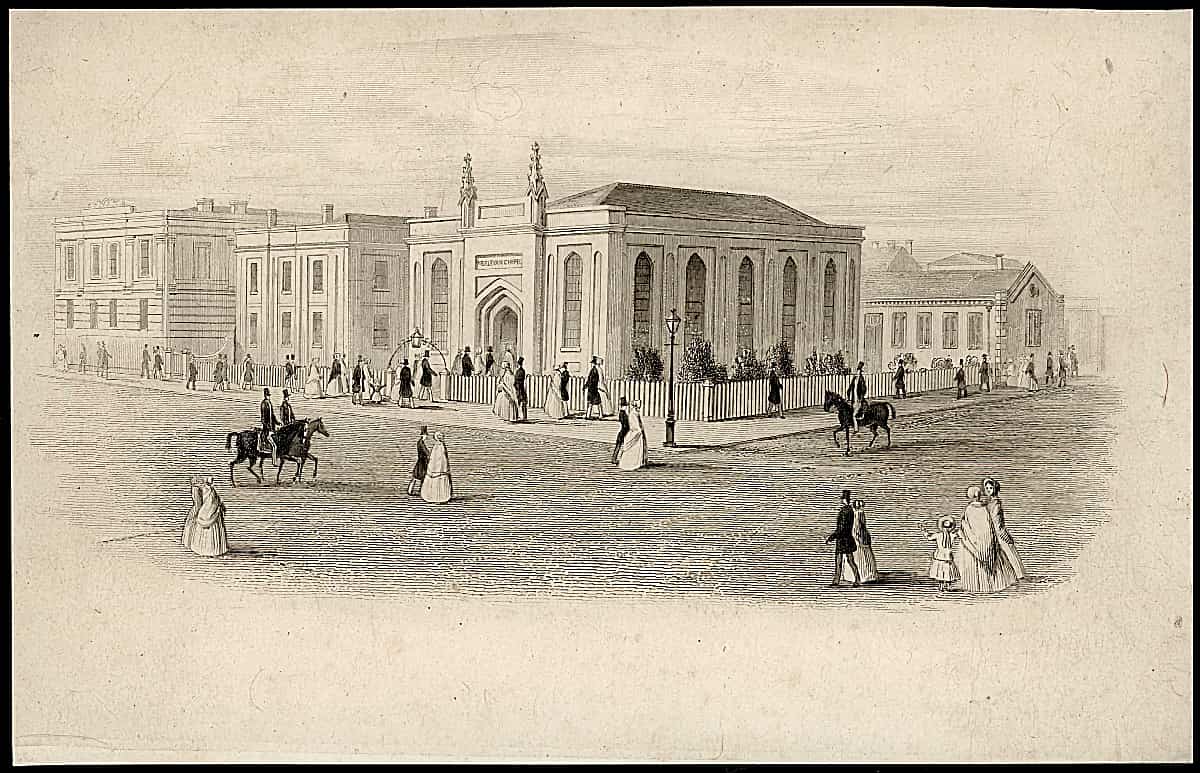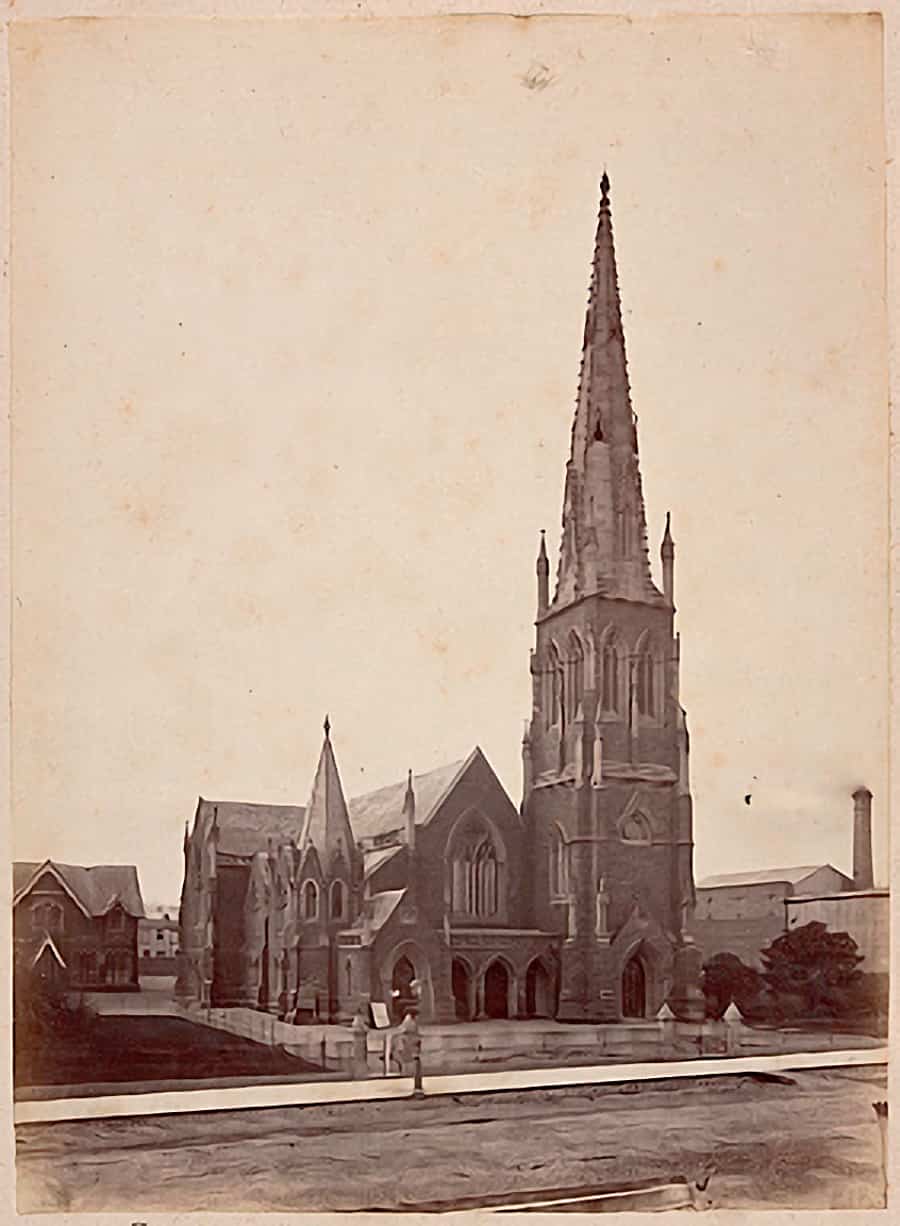
Wesleyan Chapel, cnr Collins & Queens Streets, Melbourne
[engraving courtesy of State Library of Victoria (c.1847)]
Historical and Technical Documentation by John Maidment
© OHTA, 2021 (last updated October 2021)

Wesleyan Chapel, cnr Collins & Queens Streets, Melbourne
[engraving courtesy of State Library of Victoria (c.1847)]
Historical and Technical Documentation by John Maidment
© OHTA, 2021 (last updated October 2021)
The foundation stone of a substantial stone Wesleyan Chapel at the corner of Collins and Queen Streets, Melbourne was laid on 11 May 1840 and the building opened on 24 June 1841.1 The Richard Nicholson organ was installed here at the end of the following year.

Wesley Church, Lonsdale Street, Melbourne
[photograph courtesy of State Library of Victoria (c.1880)]
The present church building, in Decorated Gothic style, was designed by Joseph Reed. The foundation stone was laid on 2 December 1857 and the building opened on 26 August 1858.2 At the time of its construction, this was the most splendid church building in the colony of Victoria with elaborate carved stonework and impressive 175 ft tower and spire. The building contains notable windows by Brooks, Robinson and Napier Waller.
Richard Nicholson 1842

The Richard Nicholson organ photographed at Wesley Church, Melbourne
[photograph by Charles Nettleton, courtesy of State Library of Victoria (c.1868)]
The organ was opened on Monday 9 January 1843 with the performance of a Grand Oratorio.3 It was a comprehensive small three-manual organ with a four-tower case, typical of its maker.4 It included a Great chorus to four-rank Mixture, a Swell from Tenor C and a diminutive Choir Organ, although with a chorus to 2ft.
A description of the organ appeared in December 1842:
THE WESLEYAN ORGAN. — This noble instrument is at last erected in the organ gallery, which has been recently built for its reception, and, independent of its rich and racy tones, is altogether a very handsome piece of furniture. The instrument was furnished to order, by Nicholson, of Rochdale, a maker of no mean repute, and contains twenty-five stops, with two octaves of German peddles: it has also three distinct rows of keys for the swell, choir, and great organs: and the manner in which it has been put up, redounds infinitely to the credit of Mr. Hurlestone and his compeers. It is the intention of the Wesleyan body to open this organ on the evening after Christmas day, with a grand oratorio, consisting of selections from the most celebrated sacred compositions of Handel, Haydn, and Mozart, the whole of which will be performed by the chapel choir, assisted by amateurs, who are now practising under the professional eye of Mr. Clark, the organist.5
The following specification was published in June 1861 and was clearly carefully prepared by an expert.
| GREAT (from GG) Open Diapason (large scale) Open Diapason (small scale) Stopped Diapason Principal Twelfth Fifteenth Sesquialtera Trumpet spare slide Swell to Great |
8 8 8 4 2-2/3 2 IV 8 |
wood |
|
| SWELL (from Tenor C) Open Diapason Stopped Diapason Principal Twelfth Fifteenth Trumpet Hautboy |
8 8 4 2-2/3 2 8 8 |
||
| CHOIR (from GG) Stopped Diapason Dulciana Principal Flute Fifteenth Swell to Choir |
8 8 4 4 2 |
TC |
|
| PEDAL (from CC) [Open Diapason] wood Pedals to Great Pedals to Choir |
16 |
Compass: 59/24
1245 pipes6
Rebuilt Charles [J.C.W.] Nicholson 1861
“The organ has been taken down and thoroughly repaired in all its parts. The sound-boards have had new leathered valves, all the interior mechanism renewed, the actions to the keys being replaced with new trackers and wires, and all the roller boards supplied with wooden arms in place of the old iron ones. The bellows have been entirely releathered, and valves added of a peculiar nature and adaptation to the colony: the introduction of which has been effected by Mr Charles Nicholson, son of the Bradford organ builder of that name. All the pipes, both of wood and metal, have undergone a thorough cleaning and repair, and have also been revoiced. A new set of pedals have been added on quite a new plan; with new back-fall and action. The coupling stops have also been renewed. The organ has been re-erected, and brought forward considerably into the church, and also slightly raised. The organ was formally opened by a grand vocal and instrumental performance. The organ was played by Mr G.R.G. Pringle, organist of St Peter’s.”7
Rebuilt & enlarged Robert Mackenzie 1873
The opportunity was also availed of to effect alterations and improvements in the organ which were greatly needed. The original compass of the instrument was GG to F, and now it is CC to G, fifty-six notes. It has been completely remodelled and great additions made, all the latest improvements being added. It now comprises: Great organ nine stops, of which two, double diapason and clarabella, are new; choir organ six stops, of which four are new viz. dulciana, viol da gamba, piccolo and clarinet; swell organ eight stops, two new, viz. double diapason and keraulophon, besides lower octave of six stops, the swell is enlarged from C go CC, new swell box, soundboards, &c; pedal organ extended from two octaves to two and a quarter octaves, thirty notes. New actions throughout, new keyboards, and draw stop action. Case enlarged and painted, and front pipes gilt… The total cost of the alterations has been £342.8
| GREAT Double Diapason Open Diapason Stopped Diapason Clarabella Principal Twelfth [Fifteenth] Sesquialtera Trumpet Swell to Great Choir to Great Sub Octave |
16 8 8 8 4 2-2/3 [2] [IV?] 8 |
new new |
|
| SWELL Double Diapason Open Diapason Stopped Diapason Keraulophon Principal Fifteenth Trumpet Oboe |
16 8 8 8 4 2 8 8 |
new new |
|
| CHOIR Stopped Diapason Viol da Gamba Dulciana Flute Piccolo Clarinet |
8 8 8 4 2 8 |
new new new new |
|
| PEDAL Grand Open Diapason 16 Great to Pedals Swell to Pedals Choir to Pedals |
16 |
3 composition pedals to Great
3 composition pedals to Swell9
Rebuilt Fincham & Hobday 1892
The manual slider soundboards were overhauled, the compass of three Choir stops was completed, a new detached drawstop console was provided at a lower level and tubular-pneumatic action supplied throughout. Three additional Pedal stops were supplied and tonal changes made to the Great and Swell Organs.10
| GREAT Open Diapason I Open Diapason II Horn Diapason Harmonic Flute Principal Clear Flute Twelfth Fifteenth Trumpet Clarion Great Sub Octave Great Super Octave Swell to Great Sub Swell to Great Swell to Great Super Choir to Great |
8 8 8 8 4 4 2-2/3 2 8 4 |
||
| SWELL Double Diapason Open Diapason Stop Diapason Keraulophon Voix Celeste Principal Fifteenth Mixture Trumpet Oboe Vox Humana Tremulant Super Octave |
16 8 8 8 8 4 2 II 8 8 8 |
TC |
|
| CHOIR (enclosed) Stop Diapason Viola da Gamba Dulciana Flute Piccolo Clarionet Swell to Choir |
8 8 8 4 2 8 |
||
| PEDAL Grand Open Diapason Bourdon Violoncello Trombone Pedal Octave Great to Pedal Swell to Pedal Choir to Pedal |
16 16 8 16 |
Tubular-pneumatic action
Detached drawstop console11
Rebuilt Geo. Fincham & Sons Pty Ltd 1957
This involved the conversion of the action to electro-pneumatic, the installation of a new detached stopkey console, and small tonal changes such as the provision of a Mixture to the Great Organ in place of the Horn Diapason, the provision of a Nazard to the Choir Organ in place of the Gamba, and the extension of the 1892 Pedal ranks to additional pitches.
| GREAT Open Diapason no 1 Open Diapason no 2 Claribel Principal Clear Flute Twelfth Fifteenth Mixture Trumpet Clarion Swell to Great Sub Swell to Great Swell to Great Super Choir to Great Sub Choir to Great Choir to Great Super |
8 8 8 4 4 2-2/3 2 III 8 4 |
||
| SWELL Double Diapason Open Diapason Gedact Keraulophon Voix Celeste Principal Fifteenth Mixture Trumpet Oboe Vox Humana Tremulant Sub Octave Unison Off Super Octave |
16 8 8 8 8 4 2 III 8 8 8 |
TC |
|
| CHOIR (enclosed) Stopped Diapason Dulciana Rohr Flute Nazard Piccolo Clarinet Tremulant Sub Octave Super Octave Swell to Choir Carillon |
8 8 4 2-2/3 2 8 |
||
| PEDAL Open Diapason Bourdon Violone Principal Bass Flute Viola Octave Quint B Fifteenth Trombone Great to Pedal Swell to Pedal Choir to Pedal |
16 16 16 8 8 8 5-1/3 4 16 |
A B C A B C B A |
Compass: 61/32
Detached stopkey console
Electro-pneumatic action12
Foillowing the Russell Street bombing of the police headquarters, close to the church, in 1987 the instrument was badly affected by debris and dust. It was cleaned and revoiced by Michel Alcouffe, a French organbuilder then working in Melbourne.

Wesley Church, Melbourne – the galleried interior following restoration and organ
[photograph from Facebook]
Between 1992 and 1997, the instrument received a comprehensive rebuilding by Vernon Cresswell. Four additional ranks were added [+]. Little now remains of the Richard Nicholson organ apart from a handful of pipes and remnants of the original casework. The specification now reads as follows:
| GREAT Contra Salicional Open Diapason I Open Diapason II Claribel Principal Clear Flute Twelfth Fifteenth Tierce Sesquialtera 12.17 Mixture 19.22.26 Trumpet Trompette Clarion Super Octave Swell Sub Octave to Great Swell to Great Swell Super Octave to Great Choir Sub Octave to Great Choir to Great Choir Super Octave to Great |
16 8 8 8 4 4 2-2/3 2 1-3/5 II III 8 8 4 |
A + derived B C+ |
|
| SWELL Double Diapason Open Diapason Gedact Keraulophon Voix Celeste Principal Fifteenth Mixture 12.15 Trumpet Oboe Vox Humana Schalmei Tremulant Sub Octave Unison Off Super Octave |
16 8 8 8 8 4 2 II 8 8 8 4 |
D TC + |
|
| CHOIR (enclosed) Echo Bourdon Stopped Diapason Echo Diapason Rohr Flute Piccolo Larigot Clarinet Tremulant Trumpet Trompette Carillon Sub Octave Unison Off Super Octave Swell to Choir Swell Super to Choir |
16 8 8 4 2 1-1/3 8 8 8 |
D B C (25 notes TG) |
|
| PEDAL Sub Bass Open Diapason Bourdon Violone Echo Diapason Principal Bass Flute Viola Octave Quint Fifteenth Trombone Tromba Tuba Magna Octave Tromba Cornetin Great to Pedal Swell to Pedal Choir to Pedal |
32 16 16 16 16 8 8 8 5-1/3 4 16 8 8 4 2 |
+ E F A D E F A A A B C B C |
Compass: 61/32
Detached stopkey console
Electro-pneumatic action13
+ added by Vernon Cresswell 1992-97
1 Garryowen, The Chronicles of Early Melbourne (Melbourne, 1888), pp.153-154
2 The Age, 27 August 1858, p.5 gives a comprehensive account of the building
3 Port Phillip Gazette, 11 January 1843, p.2
4 See James Berrow, The Making of an English Organ Builder: John Nicholson of Worcester (Reigate: BIOS, 2021) for examples at Whissonet, Norfolk and the Countess of Huntingdon’s Chapel, Worcester (1840)
5 Port Phillip Gazette, 3 December 1842, p.2
6 The Age, 18 June 1861, p.5. The specification given by E.N. Matthews is entirely erroneous but sadly it has been frequently quoted.
7 Ibid.
8 The Age, 30 May 1873, p.3
9 Ibid.
10 E.N. Matthews, Colonial Organs and Organbuilders (Carlton: Melbourne University Press, 1969), pp .188-189
11 Specification noted before 1957 by Dr Douglas Rankin
12 Specification noted 1966 John Maidment
13 The Organ in Wesley Church Lonsdale Street Melbourne [c.1998: leaflet]

Wesley Church, Melbourne – organ
[photograph from Pinterest]